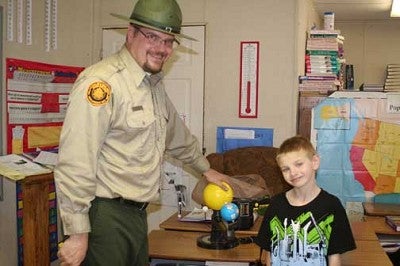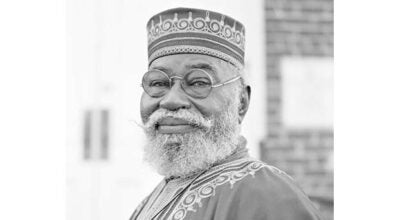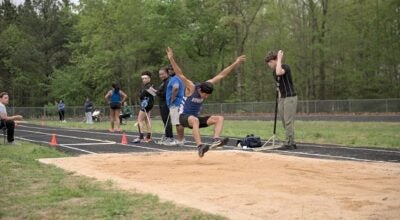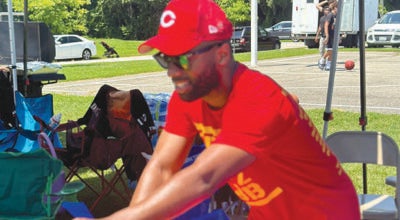Ranger Bill Brings James River State Park To Class
Published 4:55 pm Tuesday, April 17, 2012
DILLWYN – Okay, so it doesn't compare to a day at James River State Park, but students at Dillwyn Primary School know that a visit from Ranger Bill, the park's naturalist, makes for a good day at school.
Ranger Bill Crawford has become a popular visitor at DPS. Students enjoy his enthusiastic approach to learning even within the confines of a classroom.
Watching third graders mimic the rotations and revolutions of the solar system under the guidance of Crawford seemed more like viewing a human merry-go-round than a science lesson. And, the kids loved it.
Moreover, listening to the park ranger explain the moon's effect on the tides helped clarify the on-going cycle even for this seasoned beachgoer.
After his session with the students, Crawford explained that a directive of all state parks is to work closer with school systems.
On this particular day, Zane Harshman, a third grade math, science, and social studies teacher at DPS, arranged Crawford's visit.
During his previous visit to the school, the ranger offered a vocabulary-related science presentation as he talked about animals-omnivores, carnivores, and herbivores.
Discussing the in-school program, Crawford offered, “The design is about somebody coming in from the outside and being able to reinforce what the teachers are teaching.”
He added, “And the park system is very big on making sure that our programs are SOL-based.”
According to Crawford, when Harshman calls him to arrange a program, the teacher explains what he is teaching and requests specific points from those Standards of Learning he would like stressed in conjunction with the presentation.
Harshman shared that his introduction to the park's program was reinforced during a summer school session when they took students on a field trip to the state park and Crawford did the Skulls and Skins presentation.
The next school year, remembering how interested the students were during Crawford's presentation, Harshman called on the naturalist/interpreter about bringing Skulls and Skins to the school.
Harshman explained that during that conversation, the two talked about the possibility of other presentations focusing on the science SOLs.
He offered, “My kids hear me every single day we are here. Having him come in as an outside resource reinforces the vocabulary and gives them a different perspective.”
Continuing, the third grade teacher shared, “Mr. Harshman says it everyday but then Mr. Crawford comes in and is using the same vocabulary and telling them basically the same things I am telling them but as a park ranger. He's a different authority, a different kind of teacher.”
Harshman added, “He is giving them real world experiences and different hands-on things that I might not be able to give them.”
Crawford shared that the Skins and Skulls presentation is a good example of being able to provide a visible and hands-on presentation with an assortment of animal skins and, yes, skulls.
The ranger said a presentation on water cycles and watersheds offers several interesting hands-on opportunities suitable for the classroom. However, he noted that presentation is currently aligned with SOLs for sixth-graders.
“It's great to see the kids' eyes light up when they connect with what Mr. Harshman has been telling them,” Crawford shared.
Crawford, admitting that the tides and moon phases took some time to put together, said, “I had to prepare for this and talk to Mr. Harshman about what they were covering and keeping it SOL specific.” He added, “When they come to the park, I have a lot more latitude.”
However, Crawford explained that park employees who work as naturalists are encouraged to broaden their presentations and not do the same ones over and over.
Crawford is quick to add that Mark Schuppin, park manager at James River State Park, is very supportive about working with the schools.
According to Crawford, being in the schools with the kids is also a great way to promote James River State Park and all of Virginia's state park system.
He added, “But more importantly, I think from Mark Schuppin's perspective and mine, it's about helping to reinforce education and the hope that we can help students become more comfortable and familiar with the out-of-doors.”
Expressing his confidence in Crawford's ability in the classroom, Harshman, shared, “He comes in and does a very good job. He always has a well-prepared lesson plan.” The third grade teacher added, “And, he has a great rapport with the students.”
“And it's very cheap. Basically, it's just gas money for them to come out to do these program to reinforce what I am talking about in the classroom,” explained Harshman. “Other programs are hundreds of dollars. But here we've got a great outside resource, for pre-K through 12, for about $10 for two hours.”
Harshman stated, “This is a valuable resource for a school system experiencing budget cuts.” He continued, “To have a resource like this is extremely valuable to me as a teacher.” On a lighter note, he added, “And I don't have access to a rabbit skull or a mink skull or the furs of a fox or a deer.”
When Crawford ended his presentation on tides and moon phases, a quick review prompted raised hands and students eager to demonstrate their understanding of the subject.
Their responses demonstrated that the students were on definitely on-target with those SOLs.
From a new moon to a full moon along with a waxing and waning crescent and gibbous, they easily identified the diagrams and seemed very comfortable with the vocabulary.
Before heading to lunch, several students wanted a last look at a revolution/rotation model of the sun, earth, and moon that Crawford had on display. The ranger patiently stood by the model and offered a quick demonstration.
As the students filed out of the classroom, they cheerfully offered their thanks and farewells to Crawford.
It was evident that Ranger Bill Crawford, much like a ranger from long-ago television land, has become a real kimosabe to these students and their teacher.
More importantly, it is apparent that Ranger Crawford, like park naturalists across the state, is truly a trusted scout and faithful friend to education in and out of the conventional classroom.






